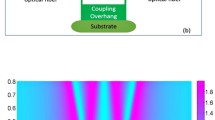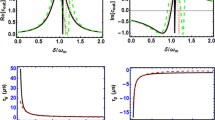Abstract
Most studies on optomechanical systems have been performed under the Markovian approximation. In this paper, we extend the study from the Markovian to the non-Markovian regime. According to the Markovian optomechanically induced transparency (OMIT) theory in Weis et al. (Science 330, 1520, 2010), we propose the non-Markovian counterpart. We find that the non-Markovianity might give rise to negative absorption, i.e., the probe field gains from the environment. By calculating the mean position of the mechanical resonator (MR), we illustrate the effect of non-Markovianity on the dynamics of the moving mirror.



Similar content being viewed by others
References
Haikka, P., Maniscalco, S.: Phys. Rev. A 81, 052103 (2010)
DiVincenzo, D.P.: Nature 393, 113 (1998)
Cirac, J.I., Ekert, A.K., Huelga, S.F., Macchiavello, C.: Phys. Rev. A 59, 4249 (1999)
DiVincenzo, D.P.: Fortschr. Phys. 48, 771 (2000)
Cirac, J. I., Zoller, P., Kimble, H.J., Mabuchi, H.: Phys. Rev. Lett. 78, 3221 (1997)
Duan, L.-M., Kuzmich, A., Kimble, H. J.: Phys. Rev. A 67, 032305 (2003)
Alicki, R., Lendi, K.: Quantum Dynamical Semigroups and Applications, Lecture Notes in Physics, 2nd edn., vol. 717. Springer, Berlin (2007)
Breuer, H.-P., Petruccione, F.: The Theory of Open Quantum Systems. Oxford University Press, Oxford (2002)
Weiss, U.: Quantum Dissipative Systems, 3rd edn. World Scientific Press, Singapore (2008)
Gardiner, C.W., Zoller, P.: Quantum Noise. Springer, Berlin (2000)
Scully, M.O., Zubairy, M.S.: Quantum Optics. Cambridge University Press, Cambridge (1997)
Walls, D.F., Milburn, G.J.: Quantum Optics. Springer, Berlin (1994)
Carmichael, H.J.: An Open Systems Approach to Quantum Optics. Lecture Notes in Physics m18. Springer, Berlin (1993)
Mandel, L., Wolf, E.: Optical Coherence and Quantum Optics. Cambridge University Press, Cambridge (1995)
Weissbluth, M.: Photon-Atom Interactions. Academic Press, Boston (1989)
Vogel, W., Welsch, D.G.: Lectures on Quantum Optics. Akademie Verlag, Berlin (1994)
Compagno, G., Passante, R., Persico, F.: Atom-Field Interactions and Dressed Atom. Cambridge University Press, Cambridge (1995)
Shen, H.Z., Qin, M., Xiu, X.M, Yi, X.X.: Phys. Rev. A 89, 062113 (2014)
Shen, H.Z., Qin, M., Yi, X.X.: Phys. Rev. A 88, 033835 (2013)
Zhang, J., Liu, Y.X., Wu, R.B., Jacobs, K., Nori, F.: Phys. Rev. A 87, 032117 (2013)
Caves, C. M., Thorne, K. S., Drever, R. W. P., Sandberg, V. D., Zimmermann, M.: Rev. Mod. Phys. 52, 341 (1980)
Barish, B. C., Weiss, R.: Phys. Today 52, 44 (1999)
Kippenberg, T.J., Rokhsari, H., Carmon, T., Scherer, A., Vahala, K.J.: Phys. Rev. Lett. 95, 033901 (2005)
Rosenberg, J., Lin, Q., Painter, O.: Nat. Photonics 3, 478 (2009)
Safavi-Naeini, A.H., Painter, O.: arXiv:1009.3529 (2010)
Weis, S., Riviere, R., Deleglise, S., Gavartin, E., Arcizet, O., Schliesser, A., Kippenberg, T. J.: Science 330, 1520 (2010)
Zhang, W. Z., Cheng, J., Li, W. D., Zhou, L.: Phys. Rev. A 93, 063853 (2016)
Zhang, J. Q., Li, Y., Feng, M., Xu, Y.: Phys. Rev. A 86, 053806 (2012)
Agarwal, G. S., Huang, S.: Phys. Rev. A 81, 041803 (2010)
Jacobs, K., Tittonen, I., Wiseman, H. W., Schiller, S.: Phys. Rev. A 60, 538 (1999)
Giovannetti, V., Vitali, D.: Phys. Rev. A 63, 023812 (2001)
Vitali, D., Gigan, S., Ferreira, A., Böhm, H. R., Tombesi, P., Guerreiro, A., Vedral, V., Zeilinger, A., Aspelmeyer, M.: Phys. Rev. Lett. 98, 030405 (2007)
Acknowledgments
This work is supported by National Natural Science Foundation of China under Grant No. 11647004 and No. 11647003.
Author information
Authors and Affiliations
Corresponding author
Appendices
Appendix A
From the Hamiltonian (4), we can obtain the Heisenberg equation of the bath operator \(\hat {b}\)
and we solve (A1) to obtain
where \(\hat {b}_{0}(\omega )\) is the value of \(\hat {b}(\omega )\) at t = 0. The Heisenberg equation of the system operator \(\hat {a}\) is
We substitute (A2) into (A3) to obtain
The final quantum langevin equation for cavity mode a can be written as
where the input field is defined as the Fourier transformation of \(k^{*}(\omega )\hat {b}_{0}(\omega )\)
The kernel f(t − t′) is given by the correlation function, which takes the form
Suppose the cavity field couple to an environment with Lorentzian spectral density
where γ is the damping rate and λ is the spectral width of coupling. In the wide-band limit (i.e., λ →∞), the spectral density approximately takes \(J(\omega )\rightarrow \frac {\gamma }{2\pi }\), equivalently, \(k(\omega )=k(\omega )^{*}\rightarrow \sqrt {\frac {\gamma }{2\pi }}\). This describes the case in the Markovian limit, and the non-Markovianity quantum Langevin equation (A5) reduce to a Markovian quantum Langevin equation as
where the Markovian input field is defined as
Appendix B
Now we rewrite the last equations of (16) as
where \(\tilde {{\Delta }}={\Delta }-\frac {g}{\hbar }q_{s}\). \(|\tilde {a}_{s}|^{2}\) can be calculated as
Substituting (B2) into the second equation of (16)
Substituting q s into \(\tilde {{\Delta }}={\Delta }-\frac {g}{\hbar }q_{s}\) and considering \(\tilde {{\Delta }}=\omega _{m}\), we get
Rights and permissions
About this article
Cite this article
Xin, C.Y., Meng, S.S. & Zhou, Y.H. Non-Markovian Effect in Optomechanical System. Int J Theor Phys 57, 1659–1670 (2018). https://doi.org/10.1007/s10773-018-3692-8
Received:
Accepted:
Published:
Issue Date:
DOI: https://doi.org/10.1007/s10773-018-3692-8




